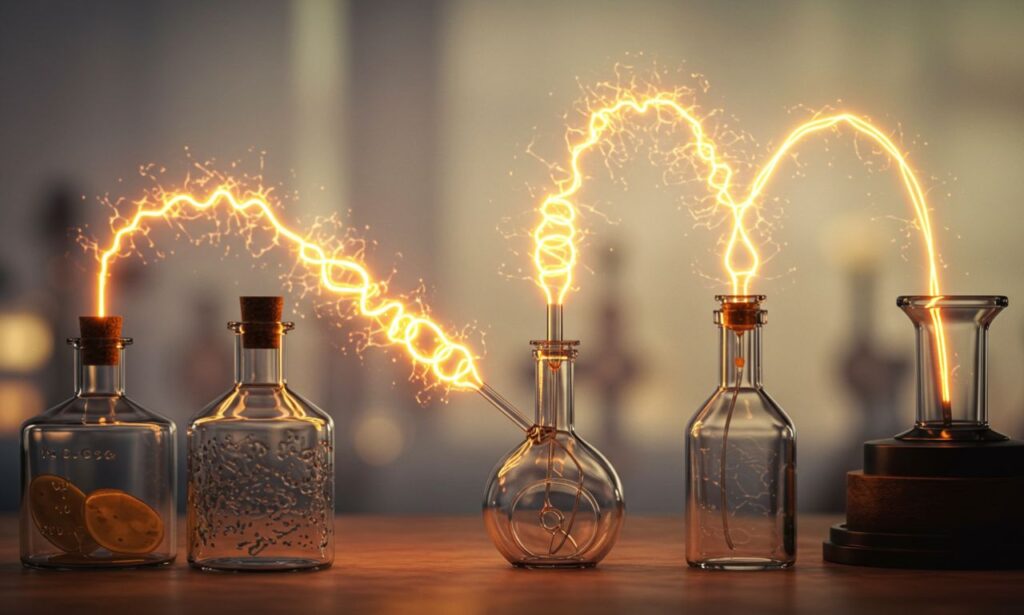The discovery of anode rays marked a pivotal moment in the evolution of atomic physics. Scientists also refer to them as positive rays or canal rays. These streams of positively charged particles emerge in discharge tubes under specific conditions. Their behavior and properties validated the existence of positively charged subatomic particles and contributed to the discovery of the proton, reshaping modern atomic theory.
Understanding anode rays helps anyone studying basic physics, chemistry, or atomic structure because they provide evidence of atomic composition beyond electrons.
What Are Anode Rays?
Anode rays consist of positively charged ions produced when ionized gas moves under low pressure and high voltage in a discharge tube. Unlike cathode rays (streams of electrons), anode rays travel in the opposite direction—from the anode to the cathode. Electric and magnetic fields affect their trajectory differently due to their opposite charge and higher mass.
The name “canal rays” comes from their ability to pass through perforations or canals in the cathode, allowing observers to detect them on the other side.
Historical Discovery of Anode Rays
In 1886, Eugen Goldstein discovered anode rays. While experimenting with cathode ray tubes, he noticed a faint glow in the direction opposite to that of cathode rays. By inserting a perforated cathode, Goldstein observed a new type of ray passing through the holes in the cathode, moving toward the opposite end of the discharge tube.
Goldstein introduced the term “canal rays” for this phenomenon. Later experiments confirmed that these rays consisted of positive ions. Ernest Rutherford used this knowledge in 1917 to identify the proton.
Formation of Anode Rays
To understand how anode rays form, consider the setup of a discharge tube:
- A glass tube holds gas at low pressure.
- Electrodes (anode and cathode) are placed at each end.
- A high voltage (thousands of volts) is applied across the electrodes.
Under these conditions, gas molecules lose electrons and turn into positive ions. The electric field pushes these ions toward the negatively charged cathode. Some ions pass through holes in the cathode, forming anode rays.
Characteristics and Properties of Anode Rays
Anode rays show distinct properties that set them apart from cathode rays. Here are their key characteristics:
1. Composed of Positive Ions
These rays consist of positively charged particles. Their mass and charge vary depending on the type of gas used in the tube.
2. Respond to Electric and Magnetic Fields
Electric and magnetic fields deflect ano de rays. Due to their positive charge, they deflect in the direction opposite to that of cathode rays.
3. Higher Mass Compared to Electrons
Positive ions carry significantly more mass than electrons. This makes their deflection less noticeable under the same electromagnetic conditions.
4. Emit a Glow Upon Impact
When ano de rays strike the glass wall or a fluorescent screen, they create a visible glow. This glow allows scientists to observe their presence and path.
5. Depend on the Type of Gas
Unlike electrons (which exist in all atoms), the composition of ano de rays varies with the gas used in the discharge tube.
Difference Between Anode Rays and Cathode Rays
| Property | Anode Rays | Cathode Rays |
|---|---|---|
| Nature | Positive ions | Electrons (negative) |
| Mass | Varies (heavier than electrons) | Constant (mass of electron) |
| Direction | From anode to cathode | From cathode to anode |
| Dependence on Gas | Varies with type of gas used | Independent of gas used |
| Deflection by Fields | Deflected oppositely to cathode rays | Deflected toward positive plate |
Understanding these differences highlights the role of ano de rays in identifying particles other than electrons in the atom.
Significance of Anode Rays in Atomic Structure
Studying ano-de rays brought several revolutionary changes in atomic theory:
1. Discovery of the Proton
Experiments using hydrogen gas revealed that the smallest ano-de ray particles carried a positive charge and minimal mass. Rutherford later identified these as protons, a fundamental subatomic particle.
2. Validation of Atomic Substructure
Before researchers identified ano de rays, electrons remained the only known subatomic particle. The existence of positive particles confirmed atoms contained more than just electrons.
3. Foundation for Mass Spectrometry
Scientists used the varying mass-to-charge ratios in ano de rays to develop mass spectrometry. This tool helped them measure atomic and isotopic masses accurately.
Applications of Anode Rays
Although newer technologies have emerged, the principles of anode rays still find relevance in many fields:
1. Mass Spectrometry
Researchers still rely on ano de ray behavior to measure atomic masses using mass spectrometers.
2. Particle Accelerators
The basic understanding of ion beams comes from early ano de ray studies.
3. Proton Source
These rays provided the first clues that led to the identification of protons, now essential in nuclear physics.
4. Educational Demonstrations
Ano de rays remain a popular subject in physics education, demonstrating foundational atomic principles.
Demonstrating Anode Rays in Experiments
In a classic experiment, a discharge tube contains:
- A perforated cathode
- Low-pressure hydrogen gas
- A high voltage power source
When activated, the setup produces a glow on a fluorescent screen placed behind the cathode. This glow comes from ano de rays striking the screen. When scientists apply electric or magnetic fields, the rays bend in a way that confirms their positive charge.
Limitations of Anode Rays
Despite their importance, ano de rays present some limitations:
- The nature of the rays changes depending on the gas.
- Their intensity remains lower than that of cathode rays, making detailed observation harder.
- Modern technology now handles tasks once performed using ano de rays more efficiently.
Modern Relevance of Anode Rays
While newer technologies have replaced many early experimental tools, the conceptual legacy of ano de rays remains strong. Their discovery led to:
- Improved atomic models
- Understanding of nuclear charge
- Identification of subatomic particles beyond electrons
Technologies like ion propulsion and plasma physics still benefit from the foundational knowledge of ano de ray behavior.
Conclusion: The Legacy of Anode Rays
Ano de rays played a key role in transforming our understanding of atomic structure. Goldstein’s experiments revealed the presence of positive ions, and Rutherford’s follow-up studies identified the proton. These findings contributed to nuclear physics and modern chemistry.
Although modern tools have replaced early anode ray experiments, their impact continues to influence science today. Their discovery teaches us how patient observation and careful experimentation can unlock the secrets of the universe.







